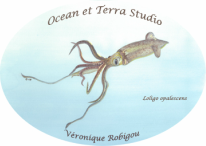 Brittany drawn when I was 8 years old.
Brittany drawn when I was 8 years old. I have been using a blue pigment dear to my heart in the past few days. And it inspires me to think about the color blue.
I love blue skies, the moody blues of the ocean, and the turquoise reflections of ice or snow that our blue planet wraps around us. Soothing hues or gloomy nuances, most of us have a natural connection with the color blue. As an artist and a scientist, I have a personal affinity to water and its ever-changing palette. My life is speckled by blue-tinted events. Picturesque villages of blue slate roofs and blue hydrangeas on ancient granite walls fill my childhood memories of vacation in Brittany. I wore my first blue jeans defiantly as a statement of independence in my provincial “lycée” and denims became my college uniform. Today, they are my choice for fieldwork, outdoors and studio garb. In graduate school I was fascinated by the mineral sillimanite in the rocks that I mapped in the White Mountains of California. A mineral curiosity, this gem of the palest blue adorns my engagement ring – a perfect color match to all my jeans and to my husband’s eyes! And how can I eloquently speak of the darkest of blue that stains the deepest waters of the Pacific Ocean? No Prussian, nor navy blue, no dark indigo, nor midnight blue comes close to the color of the abyss at 3,000 meters while looking through the porthole of a small research submarine.
It is something of a paradox that the natural, blue pigment that I am currently using in my waterscapes is derived from land – the plant Isatis tinctoria. Natural indigo pigment is extracted from the leaves of dyer’s woad or “pastel des teinturiers” the yellow flowering plant used by the Greeks and Romans for medicinal and dyeing purposes. The “pastel” pigment is mythical in my region of Lauragais in southwestern France. Extensively grown for the production of its beautiful, blue dye, the unassuming Isatis literally ignited the Renaissance in the region. As the sole source of blue tincture in Europe and the high demand of that period it brought fame and power to the Golden Triangle between the cities of Toulouse, Albi, and Carcassonne. And it sparked the legend of “Lauragais, land of milk and honey” during the 15th and 16th centuries. With maritime exploration and the opening of seagoing passages to Asia and to America, indigo pigment extracted from the “true indigo” plants (Indigofera tinctoria) dethroned dyer’s woad domination in Europe by the end of the 16th century. Natural indigo production around the world was then ruined in the 20th century by the rise of synthetic pigments.
There is a renewed interest in dyer’s woad for medicine, cosmetics, and crafts today. I am delighted that this legendary pigment, part of my culture, is again available.
Bleu de pastel de Lectoure
I love blue skies, the moody blues of the ocean, and the turquoise reflections of ice or snow that our blue planet wraps around us. Soothing hues or gloomy nuances, most of us have a natural connection with the color blue. As an artist and a scientist, I have a personal affinity to water and its ever-changing palette. My life is speckled by blue-tinted events. Picturesque villages of blue slate roofs and blue hydrangeas on ancient granite walls fill my childhood memories of vacation in Brittany. I wore my first blue jeans defiantly as a statement of independence in my provincial “lycée” and denims became my college uniform. Today, they are my choice for fieldwork, outdoors and studio garb. In graduate school I was fascinated by the mineral sillimanite in the rocks that I mapped in the White Mountains of California. A mineral curiosity, this gem of the palest blue adorns my engagement ring – a perfect color match to all my jeans and to my husband’s eyes! And how can I eloquently speak of the darkest of blue that stains the deepest waters of the Pacific Ocean? No Prussian, nor navy blue, no dark indigo, nor midnight blue comes close to the color of the abyss at 3,000 meters while looking through the porthole of a small research submarine.
It is something of a paradox that the natural, blue pigment that I am currently using in my waterscapes is derived from land – the plant Isatis tinctoria. Natural indigo pigment is extracted from the leaves of dyer’s woad or “pastel des teinturiers” the yellow flowering plant used by the Greeks and Romans for medicinal and dyeing purposes. The “pastel” pigment is mythical in my region of Lauragais in southwestern France. Extensively grown for the production of its beautiful, blue dye, the unassuming Isatis literally ignited the Renaissance in the region. As the sole source of blue tincture in Europe and the high demand of that period it brought fame and power to the Golden Triangle between the cities of Toulouse, Albi, and Carcassonne. And it sparked the legend of “Lauragais, land of milk and honey” during the 15th and 16th centuries. With maritime exploration and the opening of seagoing passages to Asia and to America, indigo pigment extracted from the “true indigo” plants (Indigofera tinctoria) dethroned dyer’s woad domination in Europe by the end of the 16th century. Natural indigo production around the world was then ruined in the 20th century by the rise of synthetic pigments.
There is a renewed interest in dyer’s woad for medicine, cosmetics, and crafts today. I am delighted that this legendary pigment, part of my culture, is again available.
Bleu de pastel de Lectoure





 RSS Feed
RSS Feed